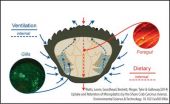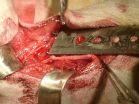(Press-News.org) The tiny plastic particles polluting our seas are not only orally ingested by marine creatures, but also enter their systems through their gills, according to a new study led by the University of Exeter.
Scientists also discovered that when microplastics are drawn in through this method they take over six times longer to leave the body compared with standard digestion.
Lead author Dr Andrew Watts of the University of Exeter said: "Many studies on microplastics only consider ingestion as a route of uptake into animals. The results we have just published stress other routes such as ventilation. We have shown this for crabs, but the same could apply for other crustaceans, molluscs and fish – simply any animal which draws water into a gill-like structure to carry out gas exchange.
"This is highly important from an ecological point of view, as if these plastics are retained longer within the animal there is more chance of them being passed up the food chain."
The researchers used fluorescently labelled polystyrene microspheres to show how ingested microplastics were retained within the body tissues of the common shore crab, Carcinus maenas. Multiphoton imaging suggested that most microspheres were retained in the foregut after sticking to hair-like 'setae' structures within the crabs.
Plastic is part of our everyday lives and has grown in use substantially over the past seven decades – from 1.7 million tonnes in 1950 to an estimated 288 million tonnes in 2013. Around 40 per cent of this is believed to come from packaging material, most of which is single use and therefore disposed of.
It has been suggested that 10 per cent of plastic which is thrown away ends up in the marine environment. At 2013 production levels this equates to 11 million tonnes of packaging ending up in the marine environment every year. This plastic is then degraded by wave action, heat or UV damage and is created into microplastic (particles smaller than 5mm).
Dr Watts added: "This is a human issue. We have put this plastic there, mostly accidently, but it is our problem to solve. The best way to do this is to reduce our dependency on plastic. It comes back to the old phrase: reduce, reuse and recycle."
The study, published in the journal Environmental Science and Technology, was funded by CleanSeas, a multidisciplinary and collaborative research project addressing marine litter from different perspectives. It aims at providing Member States and other stakeholders with improved knowledge, methods and tools to be able to better define, monitor and achieve a marine environment free of harmful litter levels by 2020 (Good Environmental Status -GES- as required by the Marine Strategy Framework Directive -MSFD). In doing so, it will deliver a set of integrated results that will provide transparent and useful guidance to policy makers and stakeholders dealing with marine litter mitigation.
INFORMATION:
Microplastics worse for crabs and other marine life than previously thought, study shows
2014-07-18
ELSE PRESS RELEASES FROM THIS DATE:
The bend in the Appalachian mountain chain is finally explained
2014-07-18
The 1500 mile Appalachian mountain chain runs along a nearly straight line from Alabama to Newfoundland—except for a curious bend in Pennsylvania and New York State. Researchers from the College of New Jersey and the University of Rochester now know what caused that bend—a dense, underground block of rigid, volcanic rock forced the chain to shift eastward as it was forming millions of years ago.
According to Cindy Ebinger, a professor of earth and environmental sciences at the University of Rochester, scientists had previously known about the volcanic rock structure under ...
Immune cell's role in intestinal movement may lead to better understanding of IBS
2014-07-18
Learning the role of immune-system cells in healthy digestive tracts and how they interact with neighboring nerve cells may lead to new treatments for irritable bowel syndrome (IBS). Researchers from Penn State College of Medicine, in collaboration with other scientists, have reported the role of macrophages in regulating the contractions of the colon to push digested material through the digestive tract.
The muscular lining of the intestine contains a distinct kind of macrophage, an immune system cell that helps fight infections. The role of these cells in normal colon ...
It's go time for LUX-Zeplin dark matter experiment
2014-07-18
New Haven, Conn. -- From the physics labs at Yale University to the bottom of a played-out gold mine in South Dakota, a new generation of dark matter experiments is ready to commence.
The U.S. Department of Energy's Office of Science and the National Science Foundation recently gave the go-ahead to LUX-Zeplin (LZ), a key experiment in the hunt for dark matter, the invisible substance that may make up much of the universe. Daniel McKinsey, a professor of physics, leads a contingent of Yale scientists working on the project.
"We emerged from a very intense competition," ...
Improving driver safety: How to prevent streetlight glare in the new world of LED lighting
2014-07-18
WASHINGTON, July 18—Long hours of nighttime driving can cause eyestrain because while our vision adapts to the surrounding darkness, the sudden stabs of brightness from streetlamps can be irritating, distracting and even painful. Even as LED technology has transformed the lighting industry, bringing the promise of more energy-efficient road illumination, some fear that the new lights could cause even more troublesome, unsafe glare.
A team of researchers from China and the Netherlands has developed a way to evaluate the human impact of uncomfortable glare caused by LED ...
NASA sees super typhoon Rammasun eyeing landfall
2014-07-18
Imagery from NASA's Aqua satellite captured a wide-eyed Typhoon Rammasun as it was making landfall in northern Hainan Island, China early on July 18. A rainfall analysis using another NASA satellite showed the flooding potential of the storm as it left the Philippines and headed for China. Now, Rammasun is headed for a final landfall near the northeastern border of Vietnam and China.
On July 17, an analysis of Typhoon Rammasun's rainfall was conducted at NASA's Goddard Space Flight Center in Greenbelt, Maryland. The rainfall analysis covered the storm's rainfall from ...
NASA satellite catches birth of Tropical Storm Wali near Hawaii
2014-07-18
The first tropical cyclone of the season has formed in the Central Pacific Ocean as NASA's Terra satellite passed overhead. Tropical Storm Wali formed southeast of the Big Island of Hawaii, and now that it's nearing, a Flash Flood Watch has been posted for all of the islands.
NASA's Terra satellite passed over Wali on July 17 at 19:55 UTC (3:55 p.m. EDT) just as it was being classified as Tropical Depression 1C. NOAA's Central Pacific Hurricane Center (CPHC) issued an advisory at 5 p.m. EDT (11 a.m. HST) announcing the birth of the depression near 12.7 north and 140.7 ...
A rhesus monkey model of radial nerve injury for evaluating peripheral nerve repair
2014-07-18
Current research on bone marrow stem cell transplantation and autologous or xenogenic nerve transplantation for peripheral nerve regeneration has mainly focused on the repair of peripheral nerve defects in rodents. Dr. Dong Wang and his team, First Affiliated Hospital of Sun Yat-sen University, China established a standardized experimental model of 2.5 cm-long radial nerve defects in rhesus monkeys and evaluated the effect of repair on peripheral nerve injury. The quality of nerve regeneration in the bone marrow stem cells-laden allografts was comparable to that achieved ...
Intranasal nerve growth factor repairs injured spinal cord neurons
2014-07-18
Nerve growth factor can be delivered to the brain by intranasal administration without risk for treatment of brain diseases. Dr. Luigi Aloe, Cellular Biology and Neurobiology Institute, National Research Council, Italy and his team performed a study to investigate whether, by intranasal administration, the nerve growth factor bypasses the blood-brain barrier and turns over the spinal cord neurons. Results showed that at 3 weeks after intranasal administration of nerve growth factor, the contents of nerve growth factor and its receptor in the spinal cord were increased, ...
How does L-carnitine maintain the normal structure of sciatic nerve in crush injury?
2014-07-18
Several studies have demonstrated that L-carnitine exhibits neuroprotective effects on injured sciatic nerve of rats with diabetes mellitus. Dr. Ümmü Zeynep Avsar, Faculty of Medicine, Ataturk University, Turkey and his team proposed a hypothesis that L-carnitine exhibits neuroprotective effects on injured sciatic nerve of rats. Rat sciatic nerve was crush injured by a forceps and exhibited degenerative changes. After intragastric administration of 50 and 100 mg/kg L-carnitine for 30 days, axon area, myelin sheath area, axon diameter, myelin sheath diameter, and numerical ...
Novel mechanism for invasion of EV71 virus demonstrated
2014-07-18
A new study determines glycosylation and pH-dependent conformational changes of virus receptor SCARB2 as crucial for EV71 attachment, entry and uncoating
Enterovirus 71 (EV71) is the major causative agent of hand, foot and mouth disease (HFMD) in the Asia-Pacific region, having caused 8.8 million infections and 3,000 deaths in China in the past five years. Unlike other enteroviruses (e.g. Coxsackievirus), EV71 can cause severe aseptic meningitis, encephalitis, myocarditis and acute flaccid paralysis, thus leading to significant fatality rates. Unfortunately, the molecular ...






